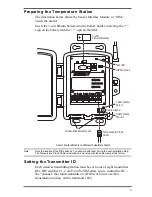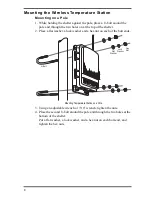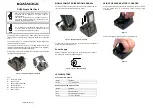
7
The following factors should be considered whether your temperature
probe is inside a radiation shield or not:
• If placing the probe on the outside of a building, a good location is
under the eaves on the north side of the building. (In the Southern
Hemisphere, the south side of a building is preferable.)
• Place the probe at least 10' (3 m) away from lights or lamps.
• Place the probe at least 5' (1.5 m) from chimneys and exhaust vents.
Range of Wireless Transmission
The range of wireless transmission depends on many factors. For the best
reception, position the transmitter shelter and your console/receiver as
close together as possible.
Range is up to 1,000' (300 m) in the line of sight, under optimal conditions.
Typical range under most conditions is 200' to 400' (75 to 150 m), but this
may be reduced by walls, ceilings, trees, or foliage. Radio-frequency
interference (RF) can also reduce transmission distance. Cordless phones
and ham radios are common examples of RF interference.
A metal roof or other large metal structure can interfere with the signal
(aluminum siding, a furnace with metal ducts, and your refrigerator are
examples). Sometimes transmission between wireless units is obscured by
something you cannot identify, or by some obstacle that you can’t work
around. If necessary, consider using Wireless Repeater #7626 or #7627 to
strengthen the signal or increase the distance between the transmitter and
the console/receiver.
Testing Transmission from Proposed Location
It is very important to test reception from the proposed location before
permanently mounting the temperature station.
Place the shelter at the intended mounting site, or have someone hold it
there, so you can walk around with the console/receiver for a few minutes.
Rotating the antenna may help to improve reception.
Test wireless reception anywhere you might want to use or mount your
console/receiver now or in the future. Take your time. If you aren’t picking
up strong signals where you intend to place your console, better to move
the shelter now than after it has been mounted. Experiment.
If you have irregular terrain in the area, it may interfere with the signal. For
example, if the transmitter is mounted downhill from the console/receiver,
the ground may block a wide angle of the transmitted signal.






























